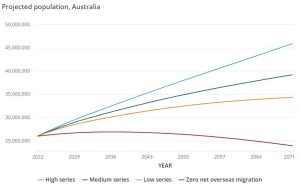Australia’s population set to hit 46 million by 2071
Australia’s population is projected to reach between 34.3 million and 45.9 million people by 2071 – up from 26 million in 2022, according to new modelling by the Australian Bureau of Statistics (ABS).
But without overseas migration, the population will decline, the ABS says.
Overseas migration will be a critical factor in this growth as the birth rate declines in relation to the numbers of people dying.
The ABS modelling charts three potential population growth trajectories – high, medium and low – which deliver varying population growth numbers.
“The current ten-year average annual growth rate (1.4 per cent) is projected to decline to between 0.2 per cent and 0.9 per cent,” the ABS report says.
It says the average age of Aussies will rise by a decade.
“The median age (38.5 years) is projected to increase to between 43.8 and 47.6 years,” the report says.
Australia’s population is set to increase by an annual average of between 1.2 per cent and 1.7 per cent until June 2032 and also grow by an annual average of between 0.6 per cent and 1.1 per cent per year over the entire projection period.
It will reach between 29.2 and 30.8 million people by 2032, and between 34.3 and 45.9 million people by 2071.
The ABS report says there were 300,700 births and 183,300 deaths during 2021-22, resulting in a natural increase of 117,400 people.
The number of births is projected to increase to between 284,700 and 482,700 births per year by 2071.
But the number of deaths is projected to reach between 378,200 and 402,800 by 2071.
This means the natural increase in population is projected to be between 118,000 and 104,500 people in 2071 – effectively a decrease.
“In all of the models, overseas migrant arrivals are assumed to exceed departures, resulting in positive net overseas migration between 9.2 million to 14.3 million in total between 2022 and 2071,” the report says.
The high and medium series both project population growth for all states and territories between 2022 and 2071.
 Victoria’s population is projected to reach between 7.6 and 8.2 million people. New South Wales is projected to reach between 9.0 and 9.7 million people and Queensland is projected to reach between 6.0 and 6.4 million people.
Victoria’s population is projected to reach between 7.6 and 8.2 million people. New South Wales is projected to reach between 9.0 and 9.7 million people and Queensland is projected to reach between 6.0 and 6.4 million people.
The low series projects growth for all states and territories except South Australia and Tasmania which would start to decline in 2039 and 2029 respectively.
Melbourne is projected to be the largest city in Australia by 2071 with a projected population between 6.5 million and 9.9 million, surpassing Sydney between 2032 and 2046.
Sydney is projected to remain constant or increase from 65 per cent of the state’s population in 2022 to 66 per cent in 2032.
Melbourne is projected to remain constant or increase from 76 per cent of Victoria in 2022 to 77 per cent in 2032.
Brisbane is projected to increase from 49 per cent of Queensland’s population to between 50 per cent and 51 per cent in 2032, becoming the majority part of Queensland’s population.
Adelaide is projected to grow from 78 per cent in 2022 to between 79 per cent and 80 per cent in 2032.
Perth is projected to remain constant or increase from 80 per cent to 81 per cent.
Hobart is projected to increase its share of Tasmania’s population, from 44 per cent in 2022 to between 45 per cent and 46 per cent in 2032.
Darwin is projected to remain constant or increase its share of the territory’s population from 60 per cent in 2022 to 61 per cent in 2032.
Read more here: Population Projections, Australia, 2022 (base) – 2071 | Australian Bureau of Statistics (abs.gov.au)












